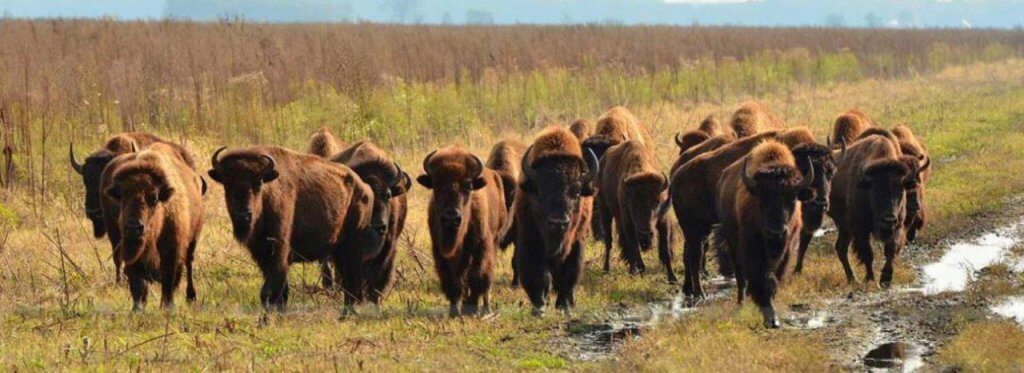
In October 2016, the Nature Conservancy brought a herd of 23 bison to roam on more than 1,000 acres at Kankakee Sands. Photo credit: The Nature Conservancy.
Long ago, a tribe of Cheyenne hunters camped at the head of a rushing stream, which eventually emptied into a large cave.
The people were starving. They hunted deer, rabbits, porcupines, birds and even skunks until all were gone.
Then they would move to a new camp. But soon all wildlife was gone there too.
Because of the great need for a new food supply for his people, the Chief called a council meeting.
“We should explore this large cave,” he told his people.
“How many brave hunters will offer to go on this venture? Of course, it may be dangerous, but we have brave hunters.”
The men were silent. No one responded to the Chief’s request.
Every morning he repeated his plea.
Finally, one young brave painted himself for hunting and stepped forth in the council.
He said, “I will go and sacrifice myself for our people.”
He arrived at the cave, near the opening, where the stream rushed underground.
There to his surprise, Young Brave found two other Cheyenne hunters, also painted for hunting.
“We will go with you,” they said.
“Are they here to taunt me,” Young Brave wondered? “Will you only pretend to jump when I do?”
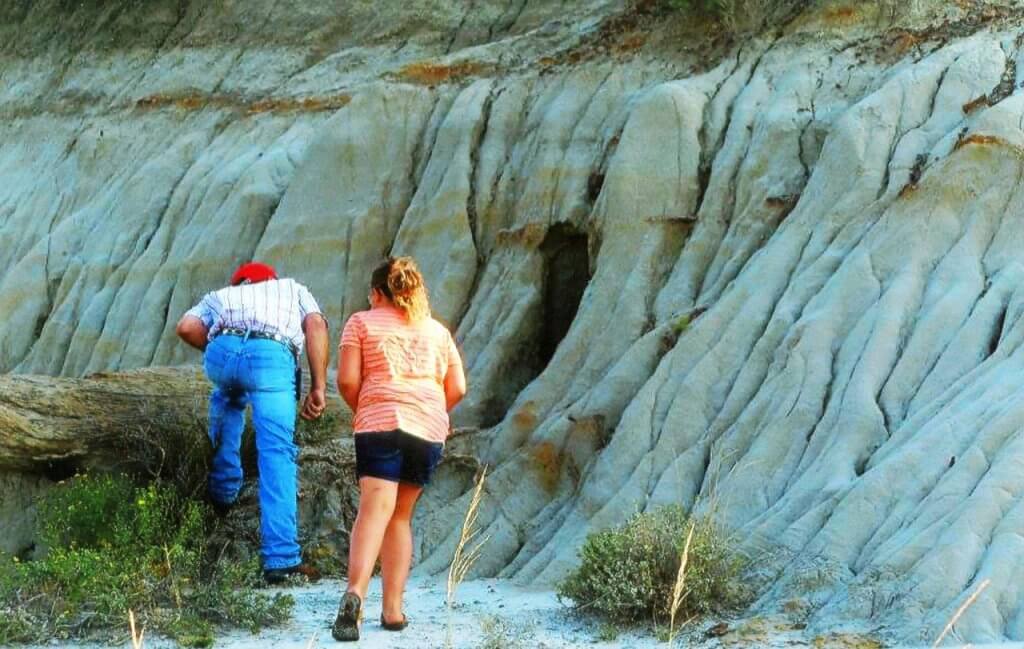
A large cave opened into a gumbo hill, where the stream rushed underground. Credit Nicole Haase.
But the other two braves assured him they would go with him, no matter how dangerous.
“You are mistaken about us. We really do want to enter the cave with you,” they said.
Young Brave then joined hands with them and they jumped into the opening of the cave. Together they tumbled down a long passage, then came to a stop.
They stood up, but because of the darkness, it took some time for their eyes to adjust.
Suddenly they saw what looked like an opening or door in the wall, with a hide hanging over it.
Young Brave knocked, but there was no response. He knocked again, much louder. Then they heard a frail voice.
An old Indian grandmother pulled back the hide and opened the door. “Where did you come from? And what do you want, my brave ones?” she asked.
“Grandmother, we are searching for a new food supply for our tribe,” Young Brave replied politely. “Our people never seem to have enough food to eat.”
“Are you hungry now?” she asked.
“Oh, yes, kind Grandmother, we are very hungry,” all three braves answered, hopefully.
The old grandmother pulled open her door wide, inviting the young men to enter.
She took them to a window and pointed for them to look.
“Look out there!” she said.
At first it was hard to see, but soon their eyes opened and a beautiful wide prairie stretched before their eyes. Great herds of buffalo were grazing contentedly.
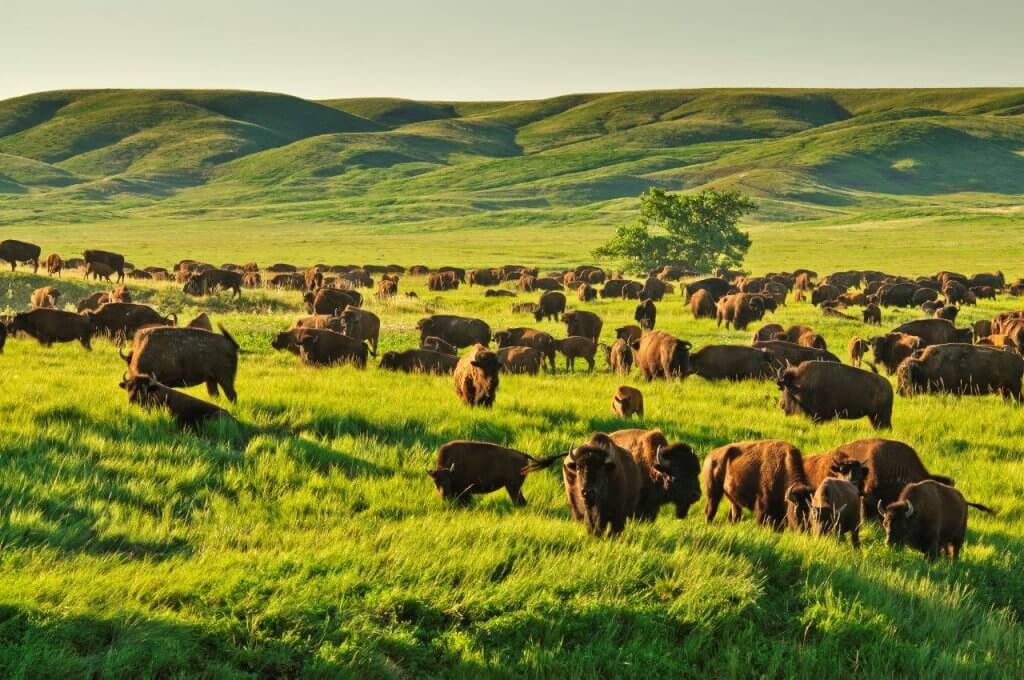
The young hunters were surprised to see outside the window great herds of buffalo grazing contentedly on the beautiful green prairie grasses. SD Tourism.
The young hunters could hardly believe what they saw!
The old grandmother told them to sit and brought each of them a stone bowl filled with buffalo meat.
How good it tasted! They ate and ate until they were full.
To their surprise, more buffalo meat still remained in their stone bowls!
“I want you to take your stone bowls of buffalo meat back to the people at your camp. Don’t spill any on the way,” said the old grandmother.
“Tell your people that soon I will send them live buffalo.”
“Thank you, thank you, thank you, kind Grandmother,” said the three young Cheyenne braves.
They took their bowls and being careful not to spill any meat, went back into the cave. It was very dark, but finally they saw a dim light and found a narrow passage.
After a time they found their way up and scaled the walls of the cave.
When the young hunters returned to their camp with gifts of buffalo meat, the people rejoiced over this new, good food.
The entire tribe ate heartily from the old grandmother’s three magic bowls, and still there was meat left over.
When the Cheyenne awoke at dawn the next day, herds of buffalo had mysteriously appeared, surrounding their village and eating the green grass in all four directions!
The people were truly thankful to the old Indian grandmother and to the Sky Spirits for their good fortune.
From then on they could hunt buffalo whenever they wanted.
But they always remembered to give thanks to all, and thanks to the buffalo—for offering up their flesh, their hides and other gifts for the Cheyenne people and their families.
http://www.firstpeople.us/FP-Html-Legends
How Coyote freed the Buffalo from Humpback
Another tradition told of the release of buffalo before they ran free over the earth. One of these involved a powerful being named Humpback who owned all the buffalo.
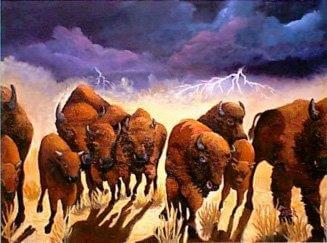
Humpback’s buffalo broke out of the corral and ran free over the earth.
In the first days a mean and powerful being named Humpback owned all the buffalo in the world. He kept them locked in a stone corral in the mountains north of San Juan, where he lived with his young son.
The buffalo were crowded into the corral, without much to eat, and most of their food was covered with dust.
They tried to reach for the green grass and sagebrush that grew outside their corral on the mountainside, but could not.
Humpback shared the buffalo with no one else and refused to give any meat to his neighbors, even though they were starving.
One summer game was very scarce. Coyote and the people hunters traveled many miles in all directions but found nothing to eat. The people and their children grew thin with hunger.
They sought help from the wily Coyote. Something had to be done to help the buffalo escape from Humpback’s corral.
Coyote and his family lived not far from the mountains. His children, too, cried because their bellies were empty.
Coyote called the people to a Council.
“Humpback will not give us any buffalo,” he said. “Let us go over to his corral and make a plan to help them escape.”
The people traveled to the mountains near Humpback’s place and camped. After dark they inspected his buffalo pens.
They found the stone walls had no opening. They were too high to climb. The only entrance was through the back door of Humpback’s home.
For four days they watched the father and son and the buffalo.
Then Coyote summoned the people to another Council and asked them to offer suggestions for releasing the buffalo.
“There is no way,” said one older man. “To release the buffalo we must go into Humpback’s house, and he is too powerful for us to do that.”
“I have an idea,” Coyote said. “For four days we have secretly watched Humpback and his young son go about their work.
“Have you noticed that the boy is lonesome? He does not own a pet of any kind?”
The people did not understand what this had to do with freeing the buffalo, but they knew that Coyote was a great schemer so they waited for him to explain.
“I will change myself into a Killdeer,” Coyote said. “In the morning when Humpback’s son goes down to the spring to get water, he’ll find a Killdeer with a broken wing.
“He will want this bird for a pet and take it back into his house.
“Once I am in the house I can fly into the corral, and the cries of the Killdeer will frighten the buffalo into a stampede. They will come charging out through Humpback’s house and be free to run upon the earth.”
The people thought this was a good plan, and the next morning when Humpback’s son came down the path to the spring he found the Killdeer with a crippled wing.
As Coyote had planned, the boy picked up the bird and carried it back into his lodge.
“Look here,” the boy cried. “This is a very good bird!”
“It is good for nothing!” Humpback shouted at him. “All the birds and animals and people are rascals.”
“It is a very good bird,” the boy repeated.
Humpback wore a blue mask over his face and fierce nose. Through its slits his eyes glittered. His basket headdress was painted black with a zigzag streak of yellow to represent lightning.
“Take it back where you found it!” roared Humpback, and his frightened son did as he was told.
As soon as the Killdeer was released it flew to where the people were camped and changed back into Coyote.
“That plan did not work,” he said, “but I will try again in the morning. Maybe a puppy will be better than a bird.”
The next morning Humpback’s son found a small dog by the spring, lapping at the water.
The boy picked up the puppy and hurried home.
“Look here!” he cried. “What a nice pet I have found.”
“How foolish you are, boy!” Humpback growled. “A dog is good for nothing. I’ll kill it with my club.”
But the boy hugged the dog tightly to his chest and began crying.
“Oh, all right,” Humpback growled. “But first let me test that animal to make certain it is a dog. All animals in the world are schemers.”
He took a coal of fire from the hearth and brought it closer and closer to the dog’s eyes until it gave three rapid barks.
“It is a real dog,” Humpback decided. “You may keep it in the buffalo corral, but not in the house.”
This was exactly what Coyote wanted.
When darkness fell and Humpback and his son went to sleep, Coyote opened the back door of the house.
Then he ran among the buffalo in the corral, barking as loud as he could. The buffalo were badly scared because they had never before heard a dog bark.
When Coyote ran nipping at their heels, they stampeded toward Humpback’s house and smashed down the rear door.
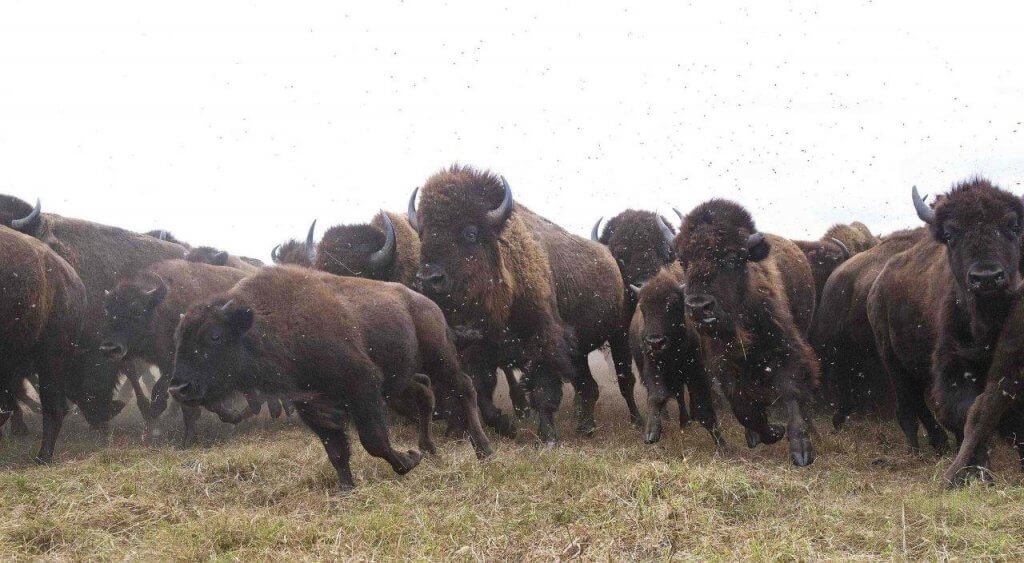
The buffalo broke through Humpback’s front door and all escaped to run free on the western plains. Nature Conservancy.
The pounding of their hooves in his house awakened Humpback. He jumped out of bed and tried to stop them, but the buffalo crashed through his front door and escaped.
All the buffalo escaped from Humpback’s corral. They scattered over all the plains and grazed on the lush green grass in the sunshine.
After the last of the big shaggy animals had galloped away, Humpback’s son could not find his small dog.
“Where is my pet?” he cried. “Where is my puppy?”
“That was no dog,” Humpback said angrily. “That was Coyote the Trickster. He has turned loose all our buffalo and we can never get them back again.”

Humpback said, “That was Coyote the Trickster. He has turned loose all our buffalo and we can never get them back again.” Photo courtesy of SD Tourism.
That was all true. The buffalo had escaped and now ran free to roam over the earth.
Coyote and the people could hunt them whenever they were hungry—but only when they thanked the buffalo for sharing their gifts.
Ancient Storytelling
Some tribes held another tradition for the origin of buffalo. Their beliefs centered on a Spirit Being who formed a buffalo shape out of mud and then breathed life into it.

Storytelling was one way that early Native Americans passed down their traditions and culture. Often families sat around the fire after dark and told stories on long winter evenings. It kept their customs, history and heritage alive from one generation to the next. Some traditional stories are still told today. Credit Cameron Nelson and Sarah VanAuken.
From this effigy came untold herds of buffalo that populated the earth.
The same traditions in different variations are often told by storytellers from different tribes, especially when those tribes shared kinship or traded with each other.
In ancient times, storytelling was an art and an important way of passing down religious beliefs, history and tribal culture.
Traditional beliefs were—and often are today—taught at a grandmother’s knee. Or told by grandfathers.
Some restrictions and taboos apply. Only special people were allowed to tell certain stories and at certain times of the year.
Some stories and traditions were passed down through a specific medicine man, and he alone was allowed to tell them.
There were traditions of the origin of buffalo, the flood that covered the earth, the close connections of the people with the spirit world of their relatives—buffalo and other wildlife and birds.
Other stories modeled good behavior such as kindness to the less fortunate and the generosity of every good hunter in sharing his game
Traditional storytellers believe the old stories are best told in the native language and to those who understand the culture.
Much of the spirit, humor and excitement are lost when stories need to be translated, they say.
Further, Cree storytellers suggest the stories lose meaning without the close connection to nature, the Great Spirit and other people, which is part of their culture and reflected in the stories told to small children from birth.
Not always do the traditional stories provide religious or cultural significance or teach a lesson

The Native American grandmother might entertain children with hilarious tales of coyote tricksters and other mischief just for the fun of it while she beaded moccasins or babysat the little ones. Credit Painting Howard Terpning.
The venerable Native grandmother, with a twinkle in her eye, might entertain with hilarious tales about coyote tricksters and other mischief.
Some stories she told just for fun of it, with twists, turns and surprises for a giggling circle of attentive children.

Francie M Berg
Author of the Buffalo Tales &Trails blog


